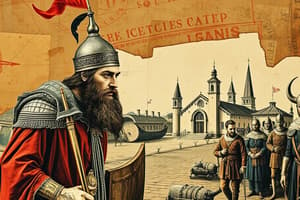Podcast
Questions and Answers
What was the dominant belief system in Europe after the fall of the Western Roman Empire?
What was the dominant belief system in Europe after the fall of the Western Roman Empire?
- Judaism
- Islam
- Buddhism
- Christianity (correct)
Which empire kept Eastern Orthodox Christianity alive after the fall of the Western Roman Empire?
Which empire kept Eastern Orthodox Christianity alive after the fall of the Western Roman Empire?
- Ottoman Empire
- Byzantine Empire (correct)
- Persian Empire
- Roman Empire
What system of allegiances characterized the social structure in Western Europe during the feudal era?
What system of allegiances characterized the social structure in Western Europe during the feudal era?
- Socialism
- Feudalism (correct)
- Communism
- Capitalism
When did monarchs begin centralizing their power, leading to increased competition and wars in Europe?
When did monarchs begin centralizing their power, leading to increased competition and wars in Europe?
What impact did the fall of the Western Roman Empire have on Christianity in Europe?
What impact did the fall of the Western Roman Empire have on Christianity in Europe?
How were peasants, or serfs, connected to the land under feudalism in Western Europe?
How were peasants, or serfs, connected to the land under feudalism in Western Europe?
What characterized the social, political, and economic order in Western Europe during the feudal era?
What characterized the social, political, and economic order in Western Europe during the feudal era?
Which empire had significant influence on Eastern Mediterranean and Southwest Europe until its fall to the Ottoman Empire?
Which empire had significant influence on Eastern Mediterranean and Southwest Europe until its fall to the Ottoman Empire?
What effect did the fall of the Byzantine Empire have on Eastern Orthodox Christianity?
What effect did the fall of the Byzantine Empire have on Eastern Orthodox Christianity?
What was the relationship between powerful lords and monarchs under the feudal system?
What was the relationship between powerful lords and monarchs under the feudal system?
Study Notes
- During the Roman Empire, Christianity became the official state religion, but after the fall of the Western Roman Empire in 476 CE, the Byzantine Empire kept Eastern Orthodox Christianity alive.
- The Byzantine Empire, also known as the Eastern Roman Empire, had significant influence on Eastern Mediterranean and Southwest Europe until its fall in 1453 to the Ottoman Empire.
- Eastern Orthodox Christianity continued to be embraced by the Rus and other Eastern European peoples after the fall of the Byzantine Empire.
- Christianity remained the dominant belief system in Europe, but Islam and Judaism held important minority positions.
- In Western Europe, there were no large empires, and the social, political, and economic order was organized around feudalism.
- Feudalism was a system of allegiances between powerful lords and monarchs, with land exchanged for loyalty.
- Peasants, or serfs, were bound to the land and worked in exchange for protection.
- Monarchs began to centralize their power in the 13th century, leading to increased competition and wars for influence and territory.
Studying That Suits You
Use AI to generate personalized quizzes and flashcards to suit your learning preferences.
Description
Explore an overview of the history of Medieval Europe, including the transition from the Roman Empire to the Byzantine Empire, the influence of Eastern Orthodox Christianity, the development of feudalism, and the centralization of power by monarchs.




